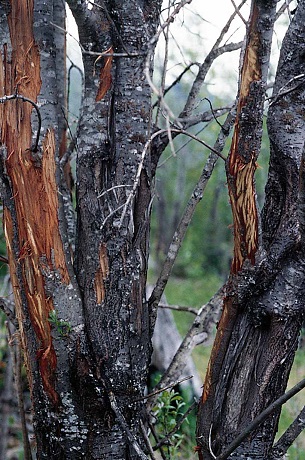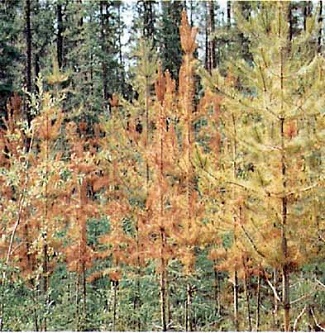Animal damage
Several mammal species damage trees in British Columbia. While these mammals cause significant damage to commercial trees, this activity is part of a healthy ecosystem of which the animals are valuable components.
All tree species, especially when seedlings or saplings, can experience animal damage.
Ungulates (hoofed animals) often feed in on nursery stocks which have higher nutrient content. Western redcedar is especially susceptible to browsing (grazing) by black-tailed deer and elk on the coast.
Cattle browse and trample seedlings and saplings when confined or insufficient fodder is available.
Wildllfe that cause significant economic losses include the American porcupine, black-tailed deer, cattle, elk, moose, red squirrel, vole and snowshoe hare. Often it's unclear which species caused specific damage because their damage symptoms are similar.
Red squirrel
Red squirrels damage young lodgepole pines and several other tree species. They cut and peel the side (lateral) and top (terminal) shoots which reduces growth. Strips of bark up to 1 cm wide are gnawed from the branches and main stems of saplings. Squirrels also remove or hollow out buds.
Vole
Voles clip the terminal and lateral shoots of small seedlings. Larger seedlings and saplings are debarked and often girdled.
Porcupine
Porcupines gnaw bark from trees which can cause tree mortality when the lower portion of the stem (trunk) is girdled.
Black bear
Black bears strip large sections of conifer tree bark and feed on the exposed sapwood.
Other wildlife causing damage
Species causing sporadic and minor losses include mountain beaver, American pika, pocket gopher, sapsucker and bushy-tailed wood rat.
Find out more about animal damage and management options available to reduce impacts on managed forests in the Field Guide to Forest Damage in B.C. (PDF, 6.6MB)

Trees with bark stripped by deer, elk or moose

Mortality due to stem girdling by snowshoe hares, a species that causes significant economic losses in B.C.
Contact information
Contact us if you have further questions about managed-stand pests and how they are controlled in B.C.
